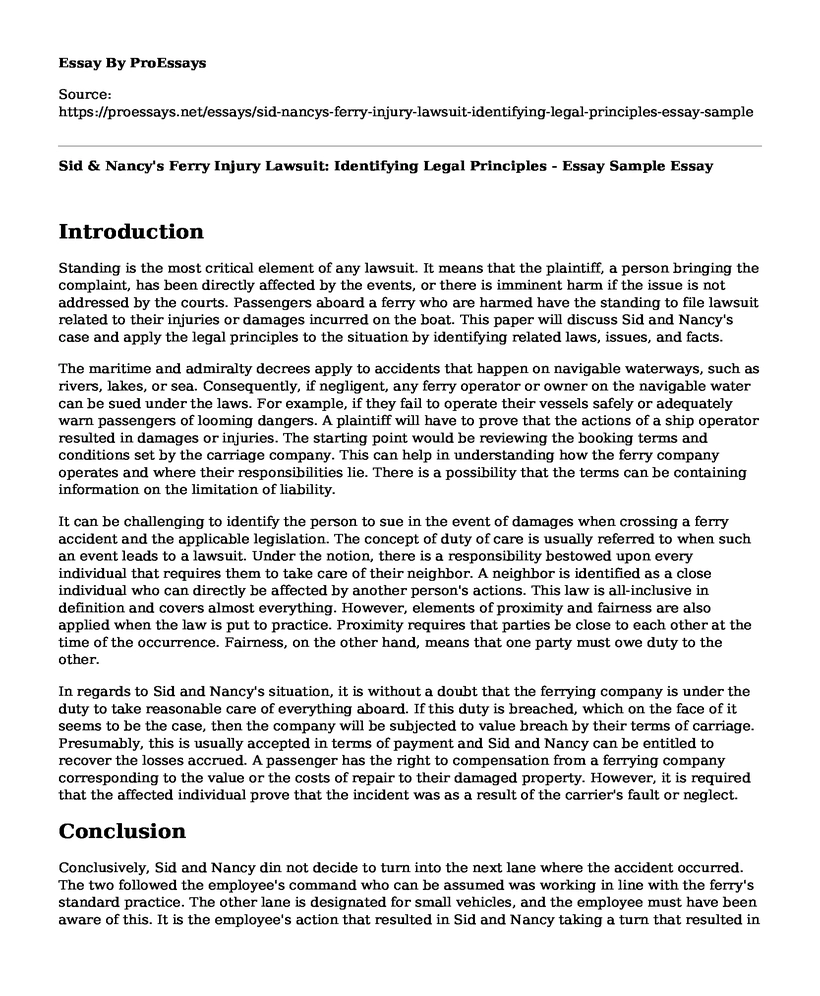Introduction
Standing is the most critical element of any lawsuit. It means that the plaintiff, a person bringing the complaint, has been directly affected by the events, or there is imminent harm if the issue is not addressed by the courts. Passengers aboard a ferry who are harmed have the standing to file lawsuit related to their injuries or damages incurred on the boat. This paper will discuss Sid and Nancy's case and apply the legal principles to the situation by identifying related laws, issues, and facts.
The maritime and admiralty decrees apply to accidents that happen on navigable waterways, such as rivers, lakes, or sea. Consequently, if negligent, any ferry operator or owner on the navigable water can be sued under the laws. For example, if they fail to operate their vessels safely or adequately warn passengers of looming dangers. A plaintiff will have to prove that the actions of a ship operator resulted in damages or injuries. The starting point would be reviewing the booking terms and conditions set by the carriage company. This can help in understanding how the ferry company operates and where their responsibilities lie. There is a possibility that the terms can be containing information on the limitation of liability.
It can be challenging to identify the person to sue in the event of damages when crossing a ferry accident and the applicable legislation. The concept of duty of care is usually referred to when such an event leads to a lawsuit. Under the notion, there is a responsibility bestowed upon every individual that requires them to take care of their neighbor. A neighbor is identified as a close individual who can directly be affected by another person's actions. This law is all-inclusive in definition and covers almost everything. However, elements of proximity and fairness are also applied when the law is put to practice. Proximity requires that parties be close to each other at the time of the occurrence. Fairness, on the other hand, means that one party must owe duty to the other.
In regards to Sid and Nancy's situation, it is without a doubt that the ferrying company is under the duty to take reasonable care of everything aboard. If this duty is breached, which on the face of it seems to be the case, then the company will be subjected to value breach by their terms of carriage. Presumably, this is usually accepted in terms of payment and Sid and Nancy can be entitled to recover the losses accrued. A passenger has the right to compensation from a ferrying company corresponding to the value or the costs of repair to their damaged property. However, it is required that the affected individual prove that the incident was as a result of the carrier's fault or neglect.
Conclusion
Conclusively, Sid and Nancy din not decide to turn into the next lane where the accident occurred. The two followed the employee's command who can be assumed was working in line with the ferry's standard practice. The other lane is designated for small vehicles, and the employee must have been aware of this. It is the employee's action that resulted in Sid and Nancy taking a turn that resulted in their bikes being damaged. This can be considered as negligence. The worker owed Sid and Nancy a duty of care and breached it when he signaled them to enter the next lane.
Cite this page
Sid & Nancy's Ferry Injury Lawsuit: Identifying Legal Principles - Essay Sample. (2023, Feb 27). Retrieved from https://proessays.net/essays/sid-nancys-ferry-injury-lawsuit-identifying-legal-principles-essay-sample
If you are the original author of this essay and no longer wish to have it published on the ProEssays website, please click below to request its removal:
- Celebrities Entitlement to Private Life Essay
- The Family-Based Migration - Paper Example
- Essay Sample on Law and Sentencing
- Essay Example on Powell v. CA: 8th Amendment & Supreme Court Ruling
- Marijuana Legalization: Should We Take the Leap? - Essay Sample
- Obamacare Annotated Bibliography: The Benefits of ACA Under President Obama
- Unveiling Wrongful Convictions: Causes, Consequences, and Reforms in the United States - Paper Sample







